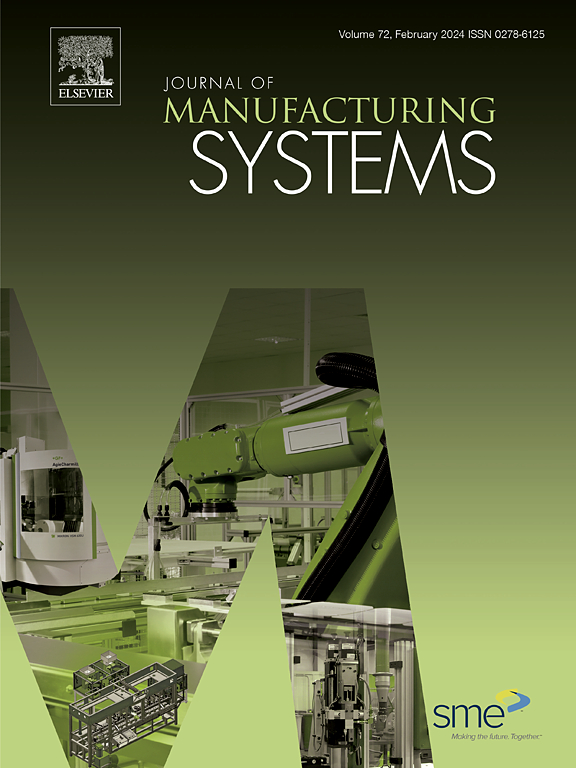Surface roughness prediction in machining using two-stage domain-incremental learning with input dimensionality expansion
IF 14.2
1区 工程技术
Q1 ENGINEERING, INDUSTRIAL
引用次数: 0
Abstract
Accurate quantification of machined surface roughness is crucial to the characterization of part performance measures, including aerodynamics and biocompatibility. Given this cruciality, there exists a need for predictive metrology models which can predict the surface roughness before a part leaves a machine to reduce metrology-induced bottlenecks and improve production planning efficiency under emergent production paradigms, e.g., Industry 4.0. Current predictive metrology approaches in machining generally train machine learning models on all available input features at once. However, this approach yields a high number of free parameters during all states of training, possibly leading to suboptimal prediction results because of the complexity of simultaneously optimizing all parameters at once. In addition, previous machine learning-enabled surface roughness prediction studies have used limited test dataset sizes, which reduces the reliability and robustness of the reported results. To address these limitations, this study proposes a two-stage model training approach based on domain-incremental learning, wherein a second stage of training is performed using an expanded input domain. The proposed method is evaluated on a 3,000-element experimentally collected testing dataset of machined H13 tool steel surfaces, where it achieves 16.3 % roughness prediction error compared to the 29.5 % error of the conventional single-stage training approach, indicating the suitability of the two-stage training method for reducing surface roughness prediction error.
基于输入维数扩展的两阶段域增量学习的加工表面粗糙度预测
加工表面粗糙度的精确量化对零件性能测量的表征至关重要,包括空气动力学和生物相容性。鉴于这一重要性,在工业4.0等紧急生产模式下,需要一种预测计量模型,可以在零件离开机器之前预测表面粗糙度,以减少计量引起的瓶颈,提高生产计划效率。目前机械加工中的预测计量方法通常是一次对所有可用的输入特征训练机器学习模型。然而,这种方法在所有训练状态中都会产生大量的自由参数,由于同时优化所有参数的复杂性,可能导致次优的预测结果。此外,以前的机器学习支持的表面粗糙度预测研究使用了有限的测试数据集大小,这降低了报告结果的可靠性和稳健性。为了解决这些限制,本研究提出了一种基于领域增量学习的两阶段模型训练方法,其中第二阶段的训练使用扩展的输入域进行。在H13工具钢加工表面3000个元素的实验测试数据集上对该方法进行了评估,与传统单阶段训练方法的29.5 %误差相比,该方法的粗糙度预测误差达到16.3 %,表明两阶段训练方法对于降低表面粗糙度预测误差的适用性。
本文章由计算机程序翻译,如有差异,请以英文原文为准。
求助全文
约1分钟内获得全文
求助全文
来源期刊

Journal of Manufacturing Systems
工程技术-工程:工业
CiteScore
23.30
自引率
13.20%
发文量
216
审稿时长
25 days
期刊介绍:
The Journal of Manufacturing Systems is dedicated to showcasing cutting-edge fundamental and applied research in manufacturing at the systems level. Encompassing products, equipment, people, information, control, and support functions, manufacturing systems play a pivotal role in the economical and competitive development, production, delivery, and total lifecycle of products, meeting market and societal needs.
With a commitment to publishing archival scholarly literature, the journal strives to advance the state of the art in manufacturing systems and foster innovation in crafting efficient, robust, and sustainable manufacturing systems. The focus extends from equipment-level considerations to the broader scope of the extended enterprise. The Journal welcomes research addressing challenges across various scales, including nano, micro, and macro-scale manufacturing, and spanning diverse sectors such as aerospace, automotive, energy, and medical device manufacturing.
 求助内容:
求助内容: 应助结果提醒方式:
应助结果提醒方式:


